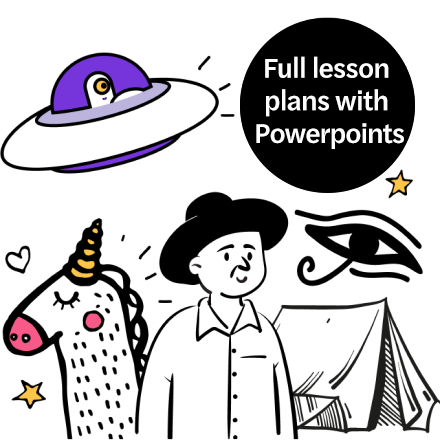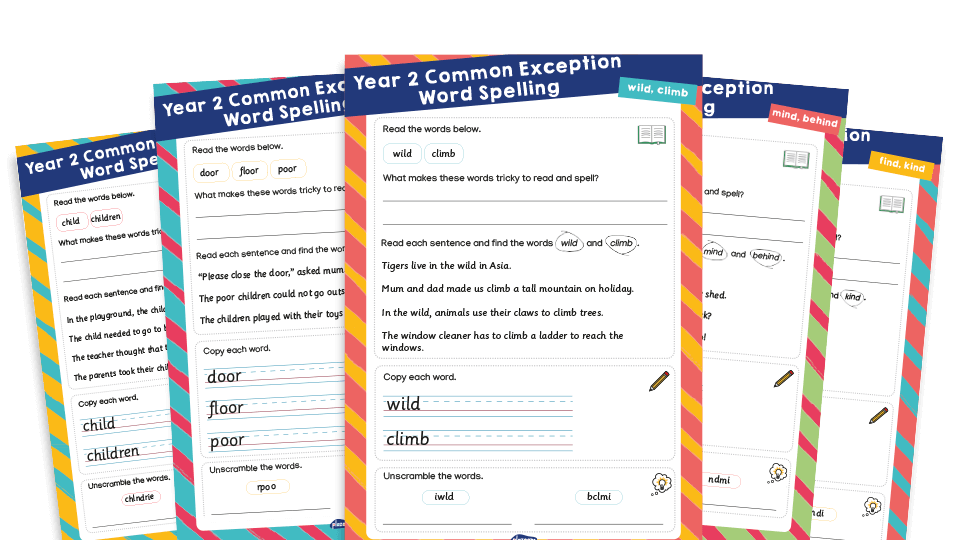Clever ways for kids to learn common exception words

If common exception words are causing a nuisance, these marvellous suggestions will take the weight off your mind…

Look at these words and decide which are spelled correctly: accomodation, seperate, supercede, minuscule.
What did you look at? Almost certainly you looked at the Cs and the M in accommodation and may have decided that one M was missing.
In separate you may have noticed that the E after the P was incorrect, while in supercede most people seem to think that is the correct spelling (it isn’t!): supersede is spelled with an S because it comes from Latin: super (above / beyond) and sedere (to sit), so that supersede means, literally, to sit above.
The only word that is correct is minuscule, but many people would expect it to be spelled with an I rather than a U, probably because they associate the smallness suggested by the word with the prefix mini- rather than minus.
The words you just looked at might be termed ‘tricky’ because they include some spellings that cause confusion.
But rather than using the term tricky words – which occurs throughout government-backed resources such as Letters and Sounds, as well as in phonics programmes such as Read Write Inc – the 2013 National Curriculum uses the term common exception words.
The curriculum requires children in Year 1 “to read common exception words, noting unusual correspondences between spelling and sound and where these occur in the word” (DfE 2013, p20).
It is important to remember that, whatever we call them, words are not tricky, only parts of some of them are.
Many English words include graphemephoneme correspondences that children have not met by the time they need to read and write them. In this article, we will focus on words that may challenge children in Key Stage 2.
Why are some words ‘tricky’?
English words derive mainly from old German and Norman French, as well as from Latin and a range of other languages, but the spellings have evolved over the years in weird and wonderful ways, often due to ignorance about etymology on the part of printers and dictionary compilers.
It is important that children understand why English spelling can be so challenging and recognise that adults also experience difficulties with many words.
In English, almost every phoneme can be represented in more than one way. Look at the following examples:
- /or/ – cork, pour, haul, paw, ball, taught, thought, score
- /r/ – run, write, hurry
- /o/ – hot, cough, want
- /s/ – sip, cell, pass, scene, psychology, dance
- /sh/ – shop, chef, conscience, spacious, initiative, sugar
In words like diarrhoea and yacht, the grapheme-phoneme correspondences for some elements do not appear in any other words children are likely to meet, so we need to focus on those parts of the word and help pupils to learn them as exceptions.
The /o/ sound in cot is the same sound that is represented by ach in yacht and the /r/ sound in rub is the same sound which is represented by rrh in diarrhoea.
The rest of each word will be familiar from words like yet, yes, got, and diagram, diagonal and idea. The key to learning the words is to focus on what is easy to learn and then learn the more difficult bit.
The same, but different…
homophones
The English language has many words that sound the same but are spelled differently (homophones – meaning same sound, from the Greek homos, same, and phone, meaning sound). Look at the words below:
wee, bee, ah, ewe, hear, know, sew, watt, wear, witch, sore, write, putt
We only know how to spell some of the words if we have some context for them. If you heard those words without seeing them and were asked to spell them, you might write:
we, be, are, you, here, no, so, what, where, which, saw, right, put
We need context for words if we are to be sure to spell them correctly. So read is the past tense of the verb to read (I read the book last week.) and red is a colour (a red shirt). For children learning to read and spell, homophones can present problems and cause misunderstandings.
heteronyms
Just to confuse matters further, English vocabulary includes several heteronyms: words that are spelled the same but pronounced differently and have different meanings. Consider how you would pronounce record and how different pronunciations would give different meanings to the word.
Consider the following words and how you would say them and what they mean. What would you need to know to ensure that you pronounced them correctly and understood their meanings?
read, sow, lead, close, rebel, desert, minute, present
As children learn more about homophones and heteronyms and become confident about their spellings, they might go on to make collections and even create their own jokes involving a play on words or misunderstandings.
Embrace the unusual
Most tricky or common exception words can be learnt using a combination of phonic strategies. It is important to emphasise that all words have grapheme-phoneme correspondences for every phoneme, even though some of these may be unusual.
For example, in the word people the /ee/ sound is represented by the diagraph /eo/, a combination of letters that actually occurs in almost 2000 English words (geography, stereo, pigeon, yeoman etc), but hardly ever to represent an /ee/ sound (diarrhoea is a rare example).
Nevertheless, when explaining how to spell and read the word people, you should point out that /ee/ is represented by eo, while explaining that this is very unusual.
Allowing children time to explore, discover and discuss common exception words is pivotal to their development as spellers. Providing a range of strategies to help children remember, and ensuring frequent exposure to these words, will assist in breaking down the barriers to spelling.
Test first, not afterwards
Use assessment to help everyone succeed…
Some schools give children the ‘test’ before they see the list of words they have to learn. This enables children to have a go at the spellings and to identify which they already know and what the tricky bits are in those they can’t yet spell accurately.
They can then focus their learning on what they actually need to remember, such as separate has “a rat” in it, and thumb ends with a b.
By using ‘tests’ in this way, we can remove the negative overtones and show that we view them as part of a learning strategy instead of an unpleasant event for some children at the end of the week.
Rather than teachers testing the whole class, children can work in pairs or groups to test each other and to help each other to learn the spellings.
If a test is administered you can collect each group’s aggregate scores rather than each individual’s. This provides a real incentive for groups to work cooperatively to help everyone to succeed.
David and Angela are joint authors, with Wendy Jolliffe, of Teaching Systematic Synthetic Phonics in Primary Schools. David has also jointly written Teaching Grammar, Punctuation and Spelling in Primary Schools and Lessons in Teaching Phonics in Primary Schools, as well as an app ‘Spelling, Punctuation and Grammar for Children Count’. All include sections on teaching tricky words.

Browse Year 3 and 4 spelling list resources, Year 5 and 6 spelling list resources and free spelling worksheets.










